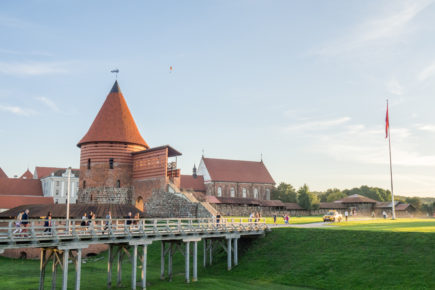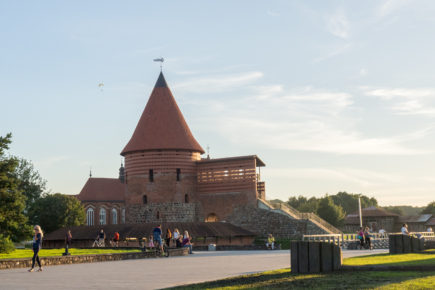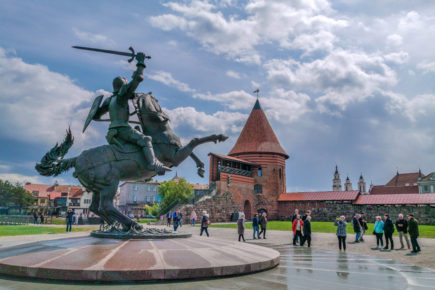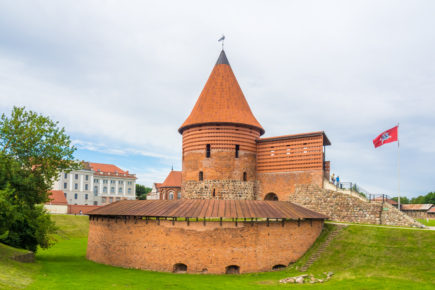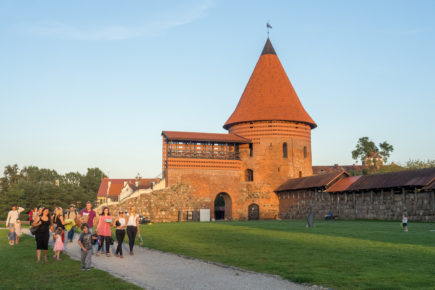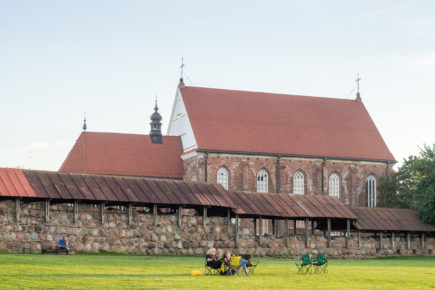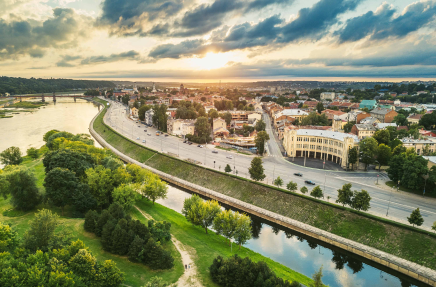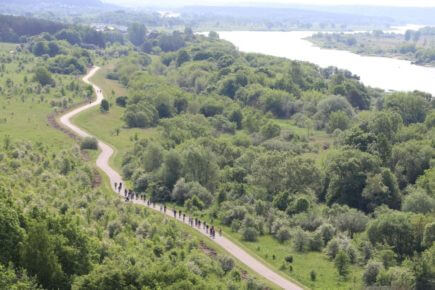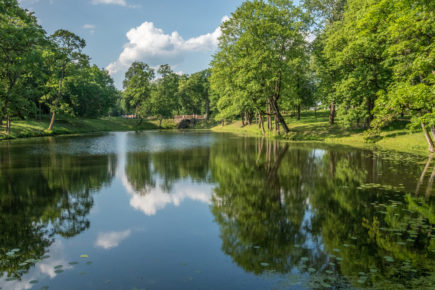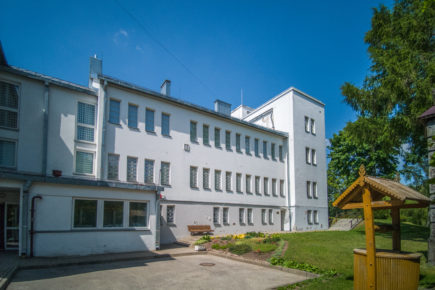Originally built to protect people, Kaunas Castle is now one of the most visited sights in the city. The castle was mentioned in written sources as early as 1361; therefore, it is a contemporary of the City of Kaunas. It saw wars that ravaged the city, withstood blows from enemies, suffered from the actions of occupiers, was revived several times, and is now open to all citizens and guests of the city.
Kaunas Castle was first mentioned in written sources in 1361, when the medieval chronicler Vygandas Marburgietis in the New Prussian Chronicle mentioned a crusader – the head of the Įsrūtės Castle – who was sent to Kaunas by the Marshal of the Order, but didn’t manage to cross the Nemunas River with his soldiers. The ruins of the 13th-14th century castle are a monument of military architecture of the 14th and 17th centuries. The remains of the castle (a fragment of the eastern wall with a gate arch, 2-3-metre high lower part of the southern wall and the contour marked by the western wall) form a semi-enclosed courtyard. The bottom of a square tower remain in the southwest corner of the courtyard and the southeast corner has a circular (restored to the fourth floor) tower with a bastion at its foot. A tunnel connects the bastion’s shooting range to the ground floor of the tower, and a deep ditch surrounds the remains of the castle to the south and east.
Defensive facilities already existed on the territory of the castle in the 4th and 5th centuries. The first stone castle is believed to have been built here in the second half of the 13th century. It consisted of a courtyard of about 0.5 hectares, surrounded by a defensive wall with a deep ditch, at the bottom of which was a thick pre-castle wall (both walls made of field stones). At the top of the walls were shooting holes and wooden shooting galleries. Crusaders destroyed Kaunas Castle in 1362, while it was under the protection of a crew led by Vaidotas, the son of the Duke of the Grand Duchy of Lithuania Kęstutis. The second brick castle was built by 1368 on the foundations of the former inner wall; its masonry walls were 3.5 metres thick, about 10 meters high. Flange towers were built at the four corners of the castle, which was surrounded by a protective ditch. In the second half of the 14th century, Lithuanians and fought crusaders for the castle, and it was destroyed and repaired many times. In 1404, the castle finally came back into the hands of the Lithuanians and was a point of resistance during the Samogitian uprising of 1409 and the war with the crusaders in 1410. After the Battle of Grunwald in 1410, the military significance of the castle declined, and it became the residence of the Kaunas elder. In the second half of the 16thcentury, a bastion was constructed at the southwest tower. Between 1601 and 1611, part of the castle was washed away several times by the Neris River, and water knocked down the north wall and the two towers in the late 18th century. The castle was abandoned and eventually fell into ruin. A prison was set up in the middle part of the courtyard in the 18th century and toward the end of the century, the Sejmiks of the nobility of Kaunas County were sometimes held in Kaunas Castle. A barracks and gymnasium were established here in the first half of 19th century.
The castle underwent renovation in 1831 and 1895. After the 1863–1864 revolt, its territory was abandoned and the ruins started vanishing. A. Presas conducted research of the castle in 1925, and E. Volteris did the same in in 1930 and 1932.
In 1930, the Kaunas City Municipality bought the former buildings around the castle and tidied up the castle site. Archaeological research and conservation work were also started.
The castle was of the fence type – an irregular rectangular shape that occupied an area of about 0.5 hectares. The walls of the castle consisted of two stone shell type walls, with a hill on the interior side and a protective ditch on the exterior. Kaunas Castle had repeatedly exchanged hands until Lithuanians took it over in 1404.
In the spring of 1362, the castle was besieged by an abundant and well-prepared force of crusaders, who brought in complex siege machines that could break through the walls. Kaunas’ second brick castle was built during the reign of Vytautas, probably at the beginning of 15th century. It was erected on the site of the destroyed first castle and the temporary wooden fortifications built in its place. The remains of this castle can still be seen on the outskirts of Kaunas Old Town. The southern part of the castle with its southeast and southwest towers, the southern wall, and fragments of the eastern and western walls have survived to this day.
Kaunas Castle is a Gothic defensive building. Historians believe that Kaunas Castle is the oldest brick castle in Lithuania. This building was built in a strategically convenient location, at the confluence of the Nemunas and the Neris rivers, making it easier to defend against attacking crusaders.
Kaunas Castle is also an important part of the Hanseatic Way. The Hanseatic Way was a trade and political union of the cities of Northern Germany, Prussia and Livonia that maintained its influence in the Baltic Region for hundreds of years throughout the Middle Ages. Hanseatic League merchants came to the City of Kaunas on the Nemunas and Neris rivers after 1408, when Vytautas granted the city the rights of Magdeburg. In 1441-1532, there was an office of Hanseatic merchants (Danzig, now called Gdansk) in Kaunas. At a time when Kaunas was intensively trading with the Hanseatic League, there were craftsmen’s workshops near Kaunas Castle, which contributed to the spread of the Hanseatic Way in Lithuania.
An exclusive part of Kaunas Castle is the Kaunas Castle Museum, which hosts two exhibitions: Mosaic of the History of Kaunas Castle and Touch 17th-century Kaunas: from stone tile to potshard. The museum presents the castle’s most significant historic facts, its architectural metamorphoses and the individuals who contributed to the historical development of the castle. The exhibitions are spread out over five spaces within the castle tower. The first floor presents the most important historical facts about Kaunas Castle, in addition to authentic exhibits, castle visualisations, and archaeological finds such as arrowheads, spears, axes etc.
One of the most interesting of the museum’s attractions – a stylised castle prison where visitors can try putting on medieval chains and take a photo at the shame pole, which was once used to punish criminals. The ghost of the castle, that is, a creative video projection, can be found in the basement of the museum castle.
The third floor of the castle tower hosts the Touch 17th-century Kaunas: from stone tile to potshard exhibition, where visitors can see various examples of ceramics (such as pots, bowls, pans etc.) and explore variants of stone tiles. Visitors to the museum are also given the opportunity to try their hand at archaeology by digging up stone tiles themselves.
The City of Kaunas started from the castle and today, instead of fighting, music is played here and festivals are organised.
One of the most interesting and attention-grabbing events organised at Kaunas Castle is the Operetta in Kaunas Castle Festival. The festival, which takes place during the warm season, brings musicians and dancers to the stage to perform operettas, ballets, musicals and more. Representatives of the younger Lithuanian musical generation have successfully become famous through the festival; therefore, participating in it is a great opportunity to present oneself to a wider audience.
Contemporary art exhibitions are also set up at the entrances of Kaunas Castle, and it also serves as a venue for state celebrations and theatrical performances.
